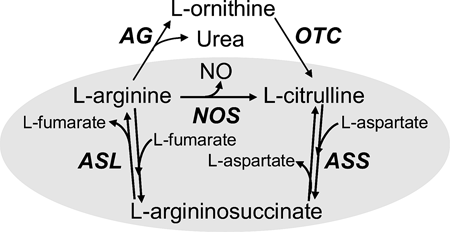Nitric oxide (NO), a gaseous signal molecule, is involved in a variety of important biological functions in the cardiovascular system, the central and peripheral nervous system, the reproductive and the immune system. NO is typically generated through enzymatic conversion of arginine (Arg) to citrulline (Cit) by NO synthase (NOS). In addition to enzymatically produced NO, there may be another source of NO in neuronal tissues containing high levels of nitrite and ascorbate. Our group has been trying to understand these enzymatic and enzyme-independent NO production mechanism chemically, temporally and spatially. Our model systems are functionally characterized and identified neurons of Aplysia californica, Pleurobranchaea californica, and Lymnaea stagnalis - three well recognized models in cellular and system neuroscience. Capillary electrophoresis with laser-induced fluorescence detection (CE-LIF) is our method of choice, which is well-suited for the analysis of individual cells, primarily because of the high separation efficiencies, ultra-small-volume sample requirements, and sensitive detection methods associated with the technique. |
A simplified schematic of the urea cycle and Cit-NO cycle (shadowed). The five enzymes involved in these two biochemical pathways include: arginase (AG), ornithine transcarbamylase (OTC), nitric oxide synthase (NOS), argininosuccinate synthetase (ASS), and argininosuccinate lyase (ASL). Image from Ye et al., J. Neurochem. 101, 2007, 632-640. |
| Relevant Publications: X. Ye, S.S. Rubakhin, J.V. Sweedler, Detection of nitric oxide in single cells, Analyst 133, 2008, 423-433. X. Ye, W.S. Kim, S.S. Rubakhin, J.V. Sweedler, Ubiquitous presence of argininosuccinate at millimolar levels in the central nervous system of Aplysia californica, J. Neurochem. 101, 2007, 632-640. X. Zhang, W.S. Kim, N. Hatcher, K. Potgieter, L.L. Moroz, R. Gillette, J.V. Sweedler, Interfering with nitric oxide measurements. 4,5-diaminofluorescein reacts with dehydroascorbic acid and ascorbic acid, J. Biol. Chem. 277, 2002, 48472-48478. |


